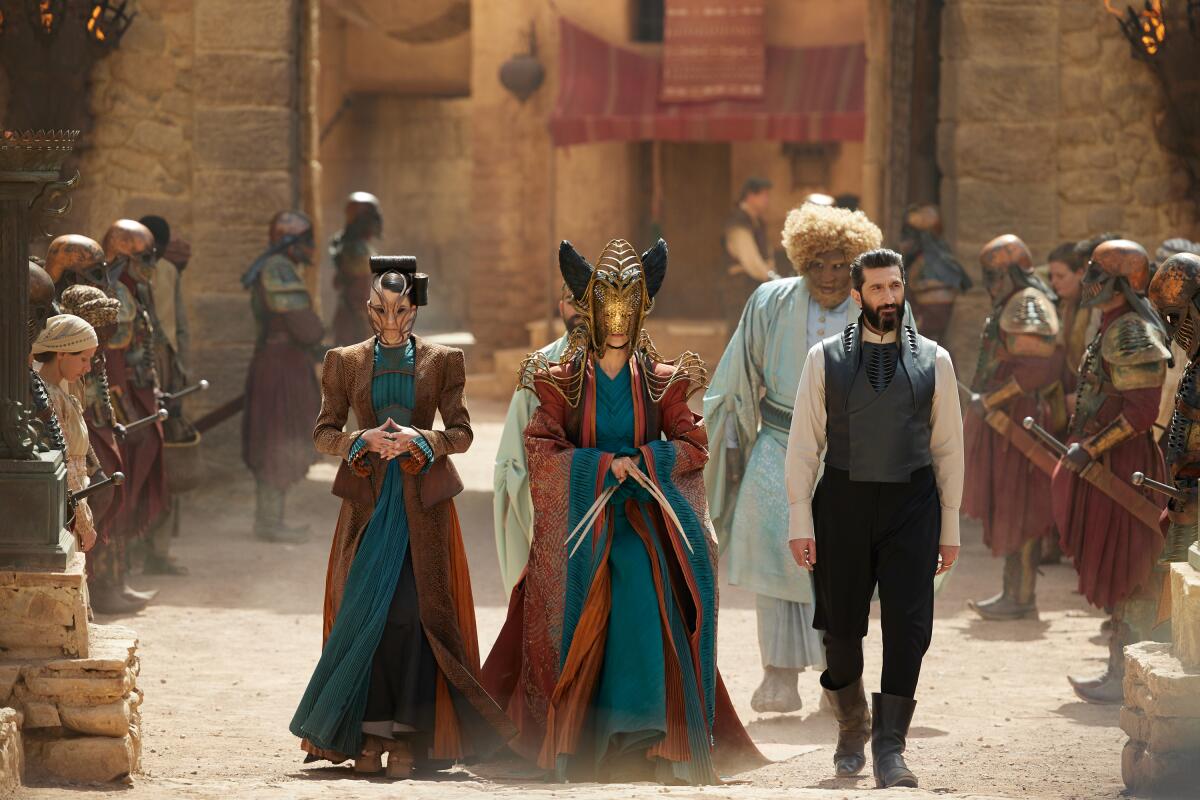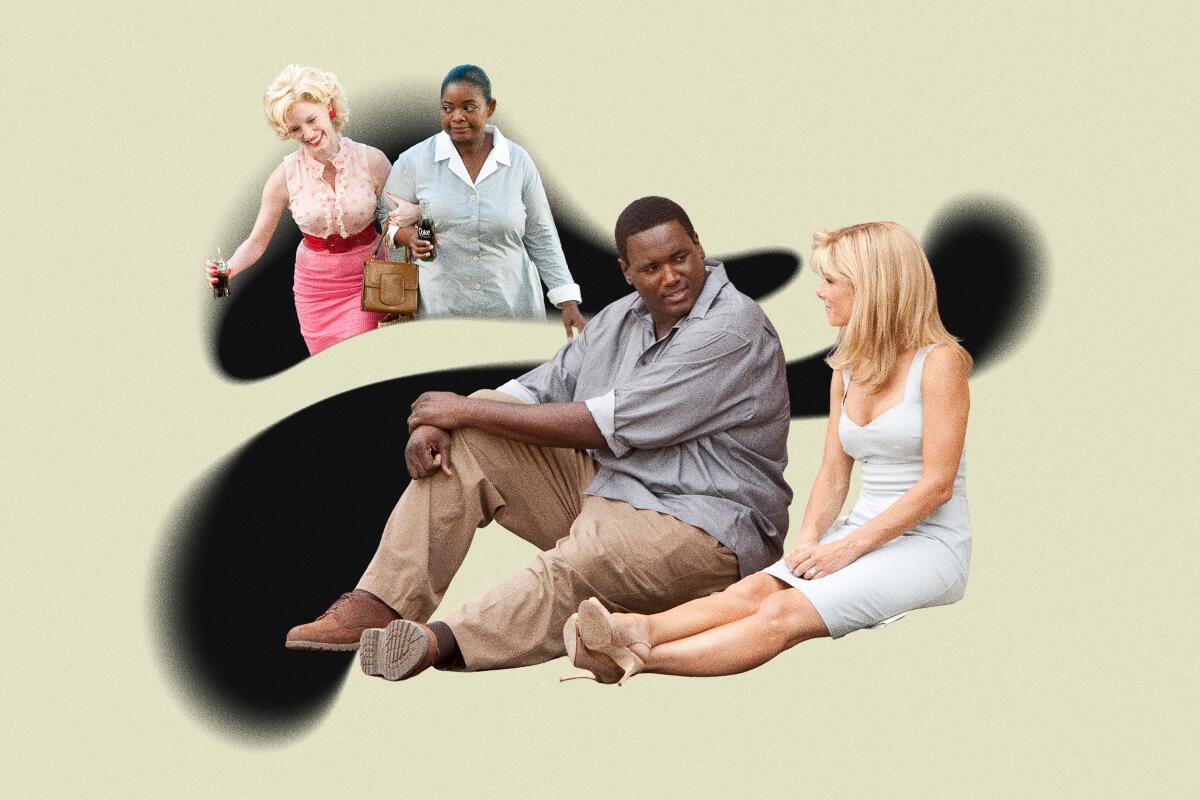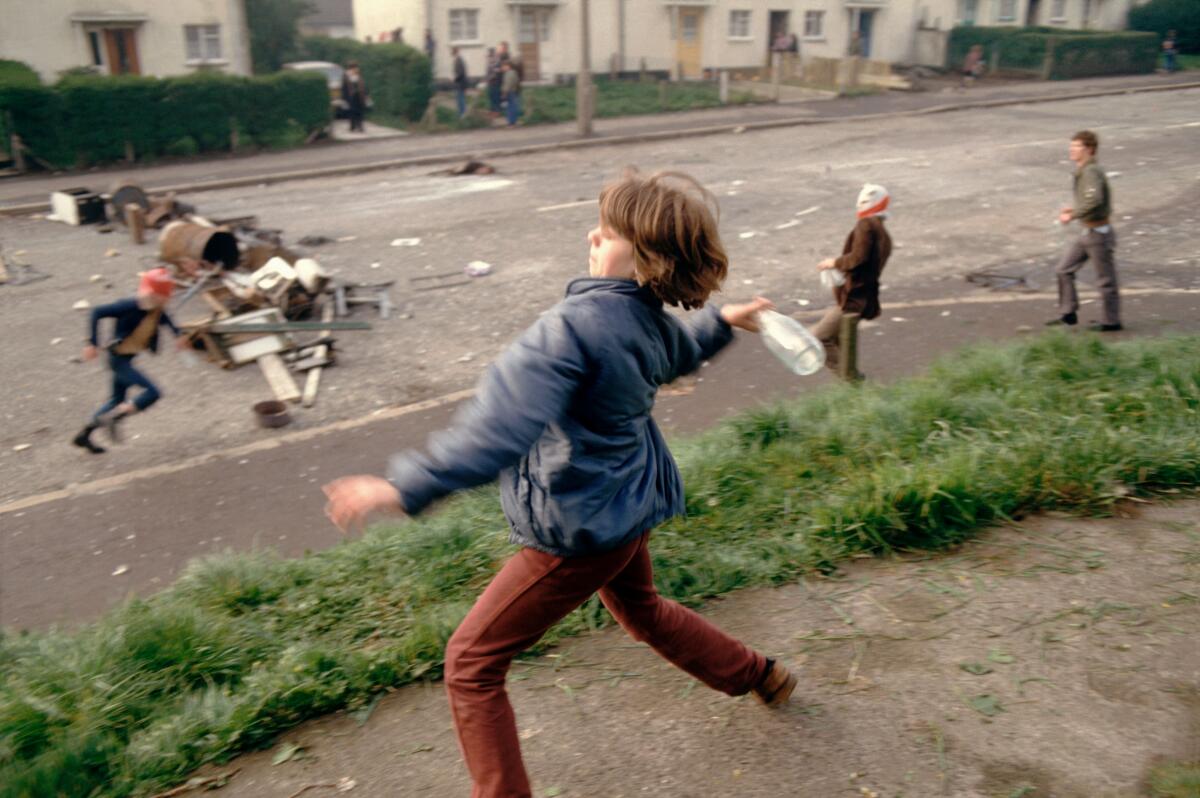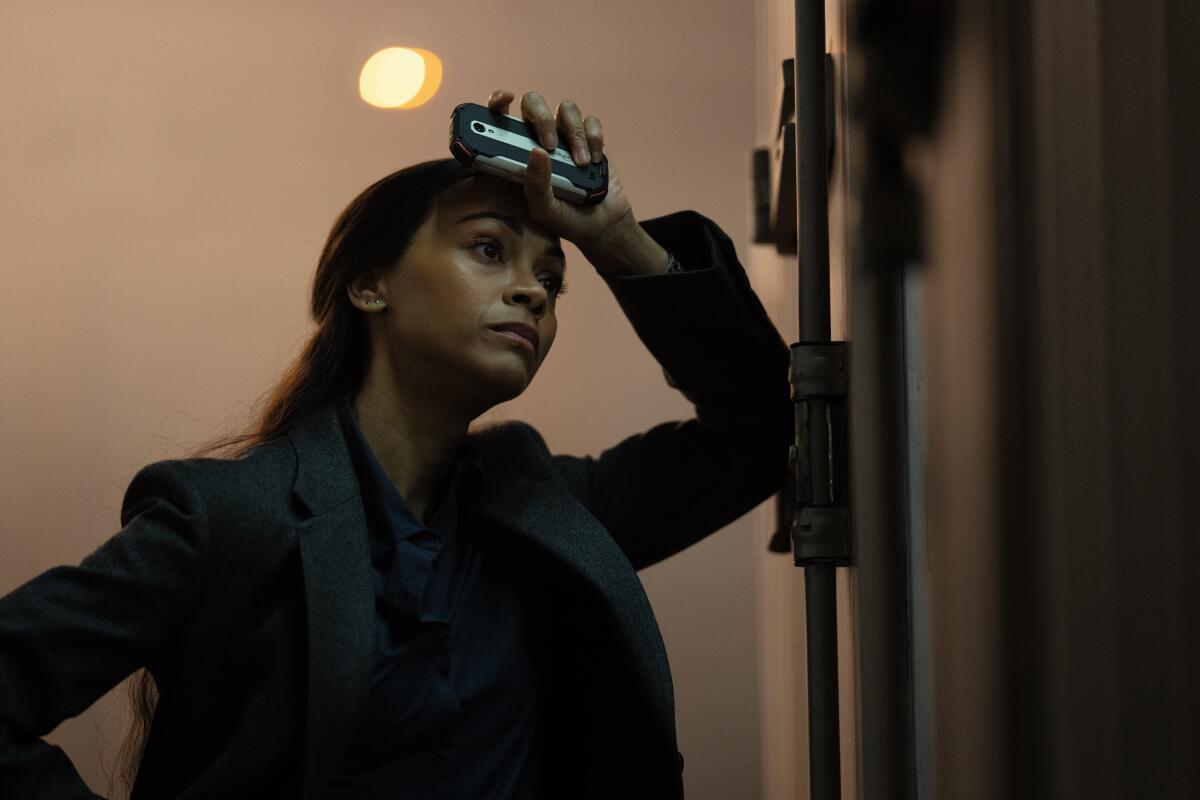How the style of Amazon’s ‘Wheel of Time’ compares to counterpart ‘The Rings of Power’

- Share via
Welcome to Screen Gab, the newsletter for everyone who ever wondered what Pablo Picasso has to do with high-fantasy storytelling.
That’s just one of the unexpected influences this week’s guest, director Sanaa Hamri — who also works on “The Rings of Power” — says inflects the style of Prime Video’s “The Wheel of Time,” which returns today for Season 2. Plus, we make the case for why it’s worth tuning into the “Special Ops: Lioness” finale and recommend a lighthearted tween movie and a searing historical docuseries to stream this weekend.
The complete guide to home viewing
Get Screen Gab for everything about the TV shows and streaming movies everyone’s talking about.
You may occasionally receive promotional content from the Los Angeles Times.
ICYMI
Must-read stories you might have missed

It’s not just ‘The Blind Side.’ In Hollywood, the ‘white savior’ won’t go quietly: The afterlives of “The Blind Side” and “The Help,” as well as the development of “Killers of the Flower Moon,” point to the tenacity of a timeworn Hollywood trope.
Dear Congress, the dirtbag detectives of ‘Telemarketers’ await your response: The amateur sleuths behind HBO’s docuseries took their investigation of telemarketing scams to Sen. Richard Blumenthal. Here’s what happened next.
There are 1,000+ episodes of ‘One Piece.’ Here are 12 of the best, according to its cast: Based on the manga series by Eiichiro Oda, ‘One Piece’ has aired more than 1,000 episodes since 1999. We asked the English voice cast to pick their favorites.
The 17 TV shows we’re most excited about this fall: Despite the strikes, which have halted production, there’s still plenty of TV coming this fall. Here are the shows our writers are most anticipating.
Turn on
Recommendations from the film and TV experts at The Times

“Once Upon a Time in Northern Ireland” (PBS, PBS Passport)
I’ll begin this recommendation with a confession: I will watch, read or listen to nearly anything about the Troubles, the brutal yet (to outsiders) baffling conflict that turned a country the size of Connecticut into a war zone for the better part of 30 years. From the bawdy sitcom “Derry Girls” to Patrick Radden Keefe’s nonfiction thriller “Say Nothing: A True Story of Murder and Memory in Northern Ireland” — count me in. So when I heard that PBS would be airing “Once Upon a Time in Northern Ireland,” a five-part BBC documentary series telling the story of the conflict from the perspective of everyday folks rather than politicians or historians, I was immediately on board.
Yet even those who don’t share my affinity for the subject matter should find “Once Upon a Time in Northern Ireland” engrossing and relevant, particularly at a time when political division makes it dangerously easy to view our own neighbors as the enemy. Directed by James Bluemel, the series, which aired on PBS this week and is available to stream on the PBS app and PBS Passport, dispenses with the talking heads to focus on ordinary people whose lives were affected, often tragically, by the Troubles. We hear from Catholics as well as Protestants; from sectarians who were actively engaged in the conflict, like Ricky O’Rawe, a former Irish Republican Army member and one of the so-called “blanket men” who shunned prison uniforms (and bathing) in an act of protest against the British government; and from regular civilians caught in its vicious crossfire, like Alan McBride, whose young wife was killed when the IRA bombed a fish shop in a loyalist section of Belfast in 1993. We hear from women who are, if anything, more impassioned and unyielding than their male counterparts. Along with the interviews is a vast amount of archival video and grainy newsreel footage, much of it harrowing.
Though the series doesn’t offer much in the way of exposition, each episode is organized around a theme and focuses on a distinct chapter in the saga, so that viewers walk away with a general sense of the chronology of the Troubles and its key turning points The final episode concludes with the Good Friday Agreement of 1998, which mostly ended the violence — if not the lingering trauma or anguish — and vividly illustrates the personal cost of peace. —Meredith Blake

“You Are So Not Invited to My Bat Mitzvah” (Netflix)
Based on the YA novel by Fiona Rosenbloom (a pseudonym of writer Amanda Stern), “You Are So Not Invited to My Bat Mitzvah” is an unusually lifelike tween comedy about friendship, broken and repaired. The latest and best product of Adam Sandler’s $350-million Netflix deal, it features a charming, delicate central performance by his daughter Sunny Sandler, with supporting turns by Sandlers père, sister Sadie and mother Jackie that, if anything, make an argument for nepotism. (Sunny’s whispering “You have coffee breath” into her father’s ear in a tender moment is as oddly lovely as anything you will encounter this season.) If not absolutely unpredictable — an embarrassing video glimpsed in the second act is bound to go off in the third — it is emotionally and, one might say, linguistically true to the self-dramatizing, critical, crucial, deeply romantic world of 12- and 13-year-olds. Among the adults (including Luis Guzmán and Idina Menzel), “Saturday Night Live’s” Sarah Sherman stands out as a plausibly hip rabbi with a Misfits sticker on her “tough love” yarmulke. —Robert Lloyd
Catch up
Everything you need to know about the film or TV series everyone’s talking about

After a shaky start in which the show lived down to its shortcomings, Taylor Sheridan’s “Special Ops: Lioness” suddenly caught fire late in its first season — just in time for a slam-bang finale.
I sympathize with the oft-expressed concerns about the show’s naked recruiting pitch for the military (if you’ve seen the first episode, you’ll know what I mean); I also narrow my eyes at its gleeful treatment of extrajudicial killings by CIA operatives on American soil and its continuation of a disturbing trend in Sheridan’s work of gratuitous, brutal violence against women, inevitably “redeemed” by revenge sequences. Still, I encourage viewers in search of compelling action-drama to watch the final three episodes of Season 1, binged together if possible.
For those who haven’t seen Episodes 6 and 7 (out of eight), I’ll keep the details vague, but they accomplish something at which few spy dramas succeed: exploding the emotional stakes.
The series had futilely attempted to root our interest in the home life of Joe (the lead CIA operative, played by Zoe Saldaña). That’s not Saldaña’s fault: The actress’ trademark authenticity is present. Still, those homefront tableaux with perfect husband and unsympathetically rebellious daughter amount to distractions from the main story, in which Joe’s rookie protégé, Cruz (Laysla De Oliveira, in a breakout performance) embeds herself with the daughter (Stephanie Nur) of a terrorism funder in order to kill him at the daughter’s wedding.
Late in the season, Cruz tumbles into an illicit affair with someone at the heart of her mission. It’s out of character for the focused Marine, though not entirely; the series effectively nurtures the growing attraction. That out-of-control plunge hooks our interest and concern. Cruz was always in over her head, but she’s now agonizingly conflicted as the moment of truth careens toward her. Can she possibly complete her mission? Can she regain the focus needed to avoid a fatal mistake? Is it even possible for her to get out alive?
To the show’s credit, the final episodes allow the mission and motivations to get murky, with direct and indirect revelations of the forces really pulling the strings. In the end, “Lioness” sticks the landing with a powerful dual payoff pairing exciting action with an emotional wallop. —Michael Ordoña
Guest spot
A weekly chat with actors, writers, directors and more about what they’re working on — and what they’re watching

It requires a sprightly mind to move between two beloved fantasy franchises. When it comes to Sanaa Hamri, though, such a feat is just the tip of the iceberg. The veteran director, who’s helmed episodes of “The Lord of the Rings: The Rings of Power” and “The Wheel of Time” (Prime Video), comes to both projects with a résumé marked by feature films (“Something New”), TV series (“Empire”) and music videos — a breadth of experience that might come in handy when imagining how women channel the power of the elements in a world broken by a madman. (Perhaps when you put it that way it’s not so much of a stretch after all.) With “The Wheel of Time,” starring Rosamund Pike, returning Friday for Season 2, Hamri stopped by Screen Gab to discuss her influences, her most memorable music video and what she’s watching. —Matt Brennan
What have you watched recently that you are recommending to everyone you know?
“The Boys” on Prime Video. It’s such a fresh approach to the traditional superhero genre. It takes all our expectations and flips them on their head while exploring the consequences of unchecked power and relevant societal issues. The cinematic style and vibe of the show are electric, not to mention the strong performances from the cast. Dark and fun!
What’s your go-to “comfort watch,” the movie or TV show you go back to again and again?
My definition of a “comfort watch” is when it’s on TV I watch it no matter what and it can stop me from changing the channel. These are the two films that do it every time: David Fincher’s “The Game” [Starz, DirecTV] and Steven Soderbergh’s “Erin Brockovich” [Tubi].
You’ve also directed episodes for another major high-fantasy series on Prime Video, “The Lord of the Rings: The Rings of Power.” Aesthetically, what would you say is the starkest difference between the two series? The greatest commonality?
Both shows have such vivid, iconic worlds that you can really sink your teeth into. This was so thrilling for me as a filmmaker. My prep process and reference points were different for each show. For example, for “The Wheel of Time” I was inspired by filmmaker Andrei Tarkovsky and early Cubist paintings of Pablo Picasso. For “The Rings of Power,” paintings by Nicolas Poussin and Michelangelo Caravaggio were huge inspirations.
I won’t ask you to pick a favorite music video you’ve directed. But I’m hoping you might share which was the most memorable to make and why.
The one that comes to mind is Prince’s “Black Sweat.” I received a call from Prince on a Wednesday night asking me about what I was doing that weekend in Los Angeles. I had nothing planned so he immediately asked me to direct a full music video Saturday … in his house! I tried to back out of it due to prep time: How am I going to get crew? Is the house even appropriate for full-on equipment load-ins while people are roaming in and out while you are there? They will know where you are staying! But Prince said, “You can figure that out, you always do!” and hangs up and emails me the song so I can come up with the concept. So now it’s Thursday and I am making calls all over town and finally by Friday I managed to cobble together an amazing, discreet crew. It is now Saturday and everyone shows up promptly at noon at Prince’s house. I started briefing Prince on the concept while he was getting ready, as he wanted to be surprised. Thankfully he loved it! The music video wound up being very special as it truly captures his essence. Lots of laughter and fun. We threw a huge party afterwards for all the crew.
The complete guide to home viewing
Get Screen Gab for everything about the TV shows and streaming movies everyone’s talking about.
You may occasionally receive promotional content from the Los Angeles Times.



